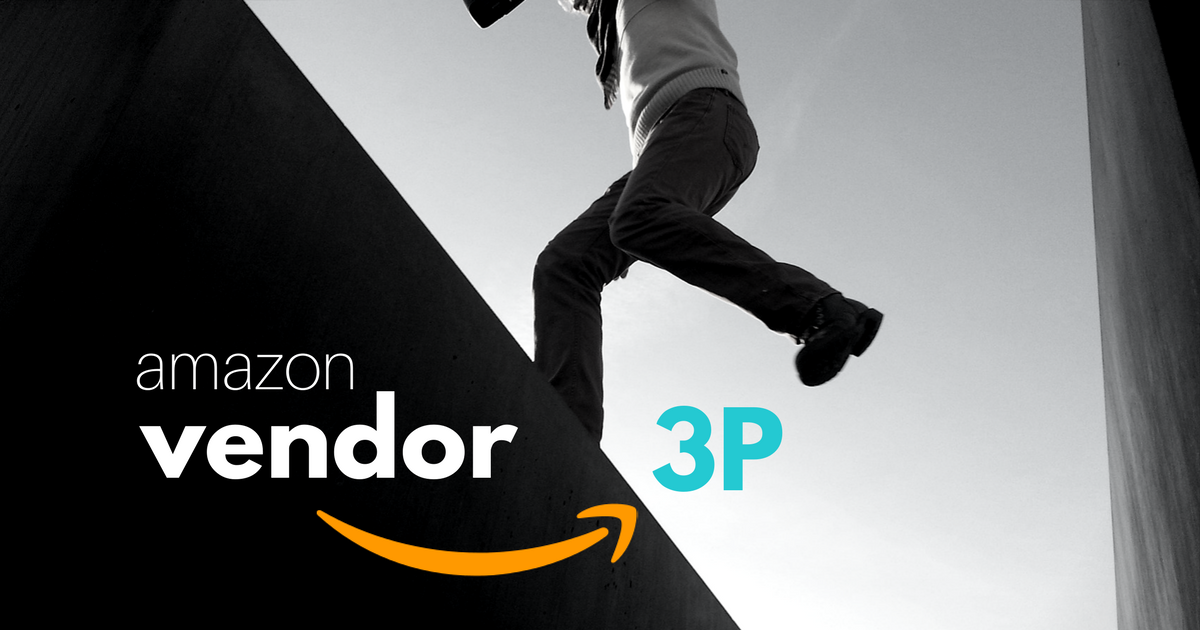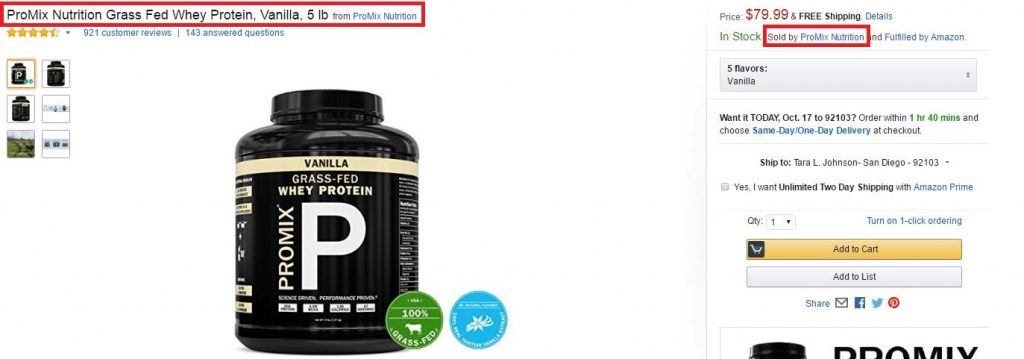Seller Central: How Amazon Vendors Transition to Third Party Sellers

UPDATE (March 2019) – Amazon Halts Purchase Orders for Vendors: How Do Amazon Vendors Transition to Seller Central?
As an agency, we’re seeing a growing number of Amazon vendors shift to the 3P side of business. But why? To start, third party sellers have more control over their products via pricing & inventory.
But the vendor to 3P transition isn’t always a walk in the park and there are several factors to evaluate when considering the shift.
We spoke with David Cooley, Manager, Marketplace Channels at CPC Strategy to discuss the differences between a full vs. partial vendor to 3P transition, as well as the advantages and challenges of the onboarding process.
Amazon to Third Party Transition Q&A:
It’s important to understand that brand owners have two options for how they want to sell their products on Amazon:

1P also known as a first-party – sell to Amazon (via purchase orders) using Vendor Central. Merchants or manufacturers sell their inventory (e.g. hats) to Amazon at wholesale rates and once those items have been sent to Amazon, the seller is done with the products. Amazon pays for the inventory directly to the seller and maintains ownership of the products.
3P also known as a third-party brand owners sell products directly to their consumers through the Amazon Marketplace using Seller Central. With Seller Central, seller accounts pay per product or a fixed fee at the end of the month. They manage shipping and customer service, unless enrolled in Amazon’s Fulfillment Program, or Fulfillment by Amazon (FBA).
“Typically, 3P sellers have more control over their products. They also have more control over their customers because if you’re a vendor you’re selling items (purchase orders) of your product(s) to Amazon (depending on how many they want to buy) and then Amazon sells those products to your customers.”
This is indicated by “Ships and Sold By Amazon.com” as seen below:

“But if you’re a 3P account, then you’re selling directly to your customers via the Marketplace and so there’s a little bit less of disconnect between the manufacturer and the actual customer. (Think of Amazon as the middle man – and you’re removing him from the equation). You’re also in control of pricing, promotions, and the number of units you want to sell.”

“If you are a vendor, it can be difficult to launch products using Vendor Central alone. Amazon has no incentive to buy that product from you because they don’t know the potential of the new product just yet. Amazon is unsure of how sales will preform. It could be a successful product in the future but Amazon isn’t likely to place purchase orders on an item with no history.”
“But if you are a 3P, you have access to a variety of advertising tools to help push the sales velocity of that new item, increase sales history, and prove to Amazon that it is a successful product. The hope is Amazon will eventually decide to place bulk purchase orders from you (for new products).”
Pro-Tip: Product selection is a critical component of the 3P account launch strategy to ensure that you are making available the best products in your catalog.
Here’s a good example of how 3P access can provide inventory coverage for vendor stockouts: As a vendor, you send in however many units (POs) to Amazon.
In the event Amazon sells through those orders (and if Amazon hasn’t purchased any additional POs from you recently) – the result is an inventory stockout.
But if you have access to the 3P side of the business, it’s kind of like having 2 offers on one product (aka on one ASIN). On one side you have your vendor offer (ships & sold by Amazon) but then you also have your second offer which is your 3p offer (sell direct to customers). So, if Amazon runs out of that particular product on the vendor side, you can at least offer a backup on the 3P side. This is pretty common use for the vendor to 3p hybrid approach.
“There can be some disadvantages. It can be a little safer to go with the vendor side of the business because once you sell your products to Amazon (and make your buck), those products are now out of your hands and under Amazon’s responsibility.
That being said, if you sell 1,000 units to Amazon, but not a single unit sells to customers – it’s likely Amazon will rethink their decision to place POs from you for that item and might decide to no longer buy any units.
But, if you’re a 3P and you have thousands of units in stock and you can’t get them to sell – then that responsibility will fall on the brand manufacturer, not you as the brand owner.
Of course, on the vendor side there are less variables to manage. Even though you don’t have control over how many units you move or the pricing of your products – vendors could can make the argument that it’s overall less to manage on regular basis. For some vendors it just gives them less in general to worry about.”
 Cost
CostAccording to an article by James Thomson, co-founder of the PROSPER Show, “Amazon Retail will negotiate hard on wholesale pricing, and typically will ask for a payment of 4-10% to help cover so-called marketing or slotting costs. As sales increase, Amazon Retail may try to re-negotiate down for lower prices, or request more fees for marketing or on-going account support.”
In contrast, the commission fee for products sold through Seller Central is fixed by category as a percentage of the selling price (typically between 8%-20%), and there are no additional selling fees to consider, which is beneficial for your bank account.
According to Thomson, “If the third-party seller is using Amazon’s fulfillment center, or FBA program, then there are other specific fulfillment costs, but those are competitive with the costs a seller might incur themselves fulfilling an order. All in all, we give the advantage to third-party, as costs are much more predictable.”
“It’s important to note we rarely go through with a FULL vendor to 3p transition. That would mean transitioning your entire business from Vendor Central over to Seller Central. Instead, we usually recommend a hybrid approach (sell products on the vendor & 3P side),” Cooley said.
“We take on a lot of vendors and approximately 10 to 20 percent of our clients will implement the hybrid approach. This allows them to take advantage of the opportunities on the 3P side without necessarily giving up on the vendor side of the business.”
“At CPC Strategy we are fortunate to have access to a specific 3P portal which gives us an inside track to Amazon’s 3P onboarding team. It provides a dedicated onboarding contact that can help vendors transition their 3P account, assist with troubleshooting, and set up their product listings.
Unfortunately, if you are transitioning to the 3P side of the business (without access to a portal) – there’s a 60 day waiting period for Buy Box eligibility. CPC Strategy’s portal allows us to bypass this waiting period – so that the brand manufacturer can get Buy Box eligibility right away.
ProTip: Amazon almost always wins the Buy Box when competing against 3P Sellers on a given listing unless the 3P offer is significantly lower in price.
But the transition process can get kind of tricky. For example, if you are an established vendor – your Amazon vendor manager can block you from creating a 3p account. Why, would they do this? Well, it has to do with the fact that Amazon Vendor Central and Amazon Seller Central are viewed as two separate entities fighting for the same business. Though Vendor Central and Seller Central fall under the wide spread e-commerce platform that is Amazon, they are very different.
If a vendor says they want to transition to the 3P side of the business – then that’s basically like you as a vendor saying you’re going to take your business away from the vendor side and move it into the 3p. You can think of it as one company losing business to another, even though it is all housed under Amazon’s roof. That is why vendor managers will sometimes block the creation of the 3p & technically they do have the final say.”
“One way to get around the vendor manager block is to create an entirely new line of business. Technically, this is possible as long as you have different account information, tax IDs, ect. At the end of the day, it would look like you have 2 separate businesses. Of course, this wouldn’t be the easiest approach, but it is an option if you get blocked.”
For more information on the Amazon to 3P transition, email [email protected]
